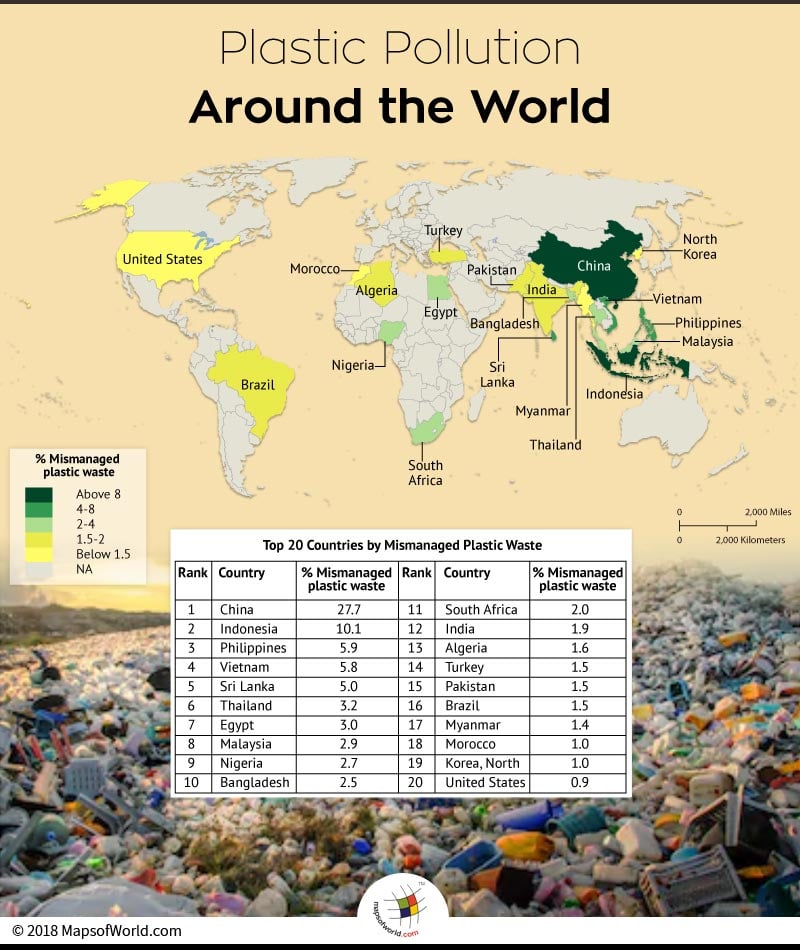

Plastic pollution is the accumulation of plastic products and have repercussions on aquatic, marine, aerial and terrestrial beings. China, is the top contributor to plastic pollution.
A simple definition of plastic suggests, a group of synthetic or natural organic materials that may be shaped when soft and then hardened. It includes resins, polymers, cellulose, derivatives, casein materials and proteins, substituting other materials like glass, wood and metals. There are three forms of plastic pollutants namely micro-plastics, mega-plastics and macro-plastics. The features like versatility, flexibility, light-weighted, moisture-resistance, strength and inexpensive, are the most attracting factors contributing to the voracious appetite. However, there are numerous additional negative factors attached to the over-consumption of plastic. This coupled with the undeniable behavioral propensity of mismanagement, discarding, littering and then polluting has led to lethal consequences.
Plastic pollution is the accumulation of plastic products and have repercussions on aquatic, marine, aerial and terrestrial beings. The mega and micro-plastics can be found in large quantities in the Northern hemisphere, concentrated around urban centers and water-fronts. As of 2018, a net of 380 million tons of plastic is produced worldwide. This plastic if not discarded judiciously, inevitably enters the environment causing great stress.
Gyres and Garbage Patches:
Remotely located, the ‘Midway Atoll’ is an isolated island lying between Asia and North America, is still not spared from the great plastic tide. It sees massive quantities of plastic debris. The reason behind the spread of plastic in the mid-oceanic open waters, is the presence of North Pacific Gyre. This has given birth to two large masses of over-accumulating plastic debris called the Great Pacific Garbage Patch.
It is a gyre of marine litter in the Central North Pacific Ocean, stretching across 1000 miles from California coast on the East to Japan and Hawaii on the West.
The Great Garbage Patch is the collective term for two separate accumulations, connected by a 6,000-mile marine litter corridor known as the North Pacific Convergence Zone. The corridor is not stationary due to the movement in the ocean currents and drifts. This also results in a massive pile-up on the beaches.
Victims:
Ranging from large mammals like whales and sea-lions to the zooplankton, plastic has been affecting marine life on and off-shores. A total of 267 different animal species have known to suffer from entanglement and ingestion of plastic debris. The land-based sources account for 80% of the world’s marine pollution, of which 60%-95% is plastic waste. The largest examples of plastic marine debris are the discarded miles-long fishing nets called the ghosts nets that restrict the movement of large sea animals, ending up drowning, starving, lacerating and infecting them.
The slow, omnipresent and ever-increasing plastic waste is toxic and has sobering consequences. The close resemblance of the plastic waste to food, results in these wastes being consumed, by the birds. The Tropic birds circling around the large plastic pile-up off the shores end up feeding on bits of plastic. Greenpeace reported a staggering 80% of sea birds population worldwide, that had ingested plastic, whereas 50%-80% of sea turtles found dead are known to have fed on plastic fragments. Research into the stomachs of dead birds, revealed 96% of the birds had plastic fragments. The ingestion of plastic, blocks the digestive tract and windpipes by cutting into the airflow, resulting into suffocation and death.
The extensive inclusion of chemicals in plastic production has developed potentially harmful effects on humans. These are carcinogenic in nature and promote endocrine disruption. Through bio-monitoring, chemicals like BPA and phthalates, have been discovered in the human population. A high content of these chemicals has led to disruptions in fertility, reproduction, sexual maturation and other health effects.
Blatantly visible, is the plastic spill washing on the shores and beaches but the problem of plastic pollution is not just an aesthetic one. It can also have adverse effects on the ecosystems. They impact the economy by affecting the coastal communities, shipping, coastal agriculture and fishing.
Hence an undeniable culture of behavioral changes needs to be adopted at all levels: individual, associative, government, legislative, industrial, technological, educational, philosophical, national and international.
Below lying table depicts top 20 countries with the highest plastic pollution:
| Rank | Country | Plastic waste | % Mismanaged plastic waste |
| 1 | China | 8.82 | 27.7 |
| 2 | Indonesia | 3.22 | 10.1 |
| 3 | Philippines | 1.88 | 5.9 |
| 4 | Vietnam | 1.83 | 5.8 |
| 5 | Sri Lanka | 1.59 | 5.0 |
| 6 | Thailand | 1.03 | 3.2 |
| 7 | Egypt | 0.97 | 3.0 |
| 8 | Malaysia | 0.94 | 2.9 |
| 9 | Nigeria | 0.85 | 2.7 |
| 10 | Bangladesh | 0.79 | 2.5 |
| 11 | South Africa | 0.63 | 2.0 |
| 12 | India | 0.60 | 1.9 |
| 13 | Algeria | 0.52 | 1.6 |
| 14 | Turkey | 0.49 | 1.5 |
| 15 | Pakistan | 0.48 | 1.5 |
| 16 | Brazil | 0.47 | 1.5 |
| 17 | Myanmar | 0.46 | 1.4 |
| 18 | Morocco | 0.31 | 1.0 |
| 19 | Korea, North | 0.30 | 1.0 |
| 20 | United States of America | 0.28 | 0.9 |
Know more:
Related maps:
The Republic of Madagascar is an island country located in the Indian Ocean, off the…
The Euro is the official currency of the European Union. It is, however, not incumbent…
There are many countries or regions that are partially recognized by the UN, have disputes…
The Alaska Statehood Act was signed into law by President Dwight D. Eisenhower in 1958,…
The name Persia may, however, only be used to refer to Iran in some contexts.…
Hawaii is an Island State in the US. It is one of the 50 states…